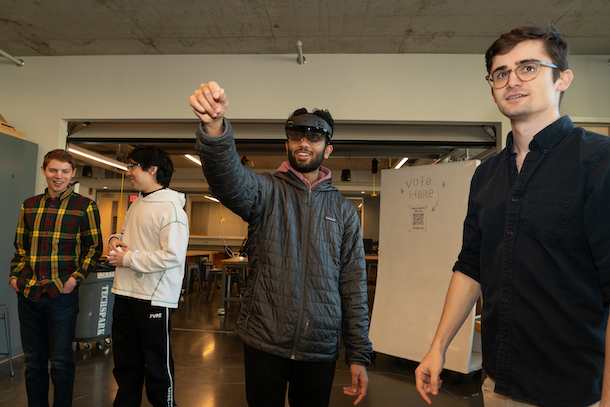Students take MSE to 3D
Monica Cooney
Apr 30, 2024

As augmented reality (AR) tools become increasingly popular for recreational and personal use, these devices are also being implemented in academic settings in a wide variety of ways.
Utilizing the capabilities of the Microsoft HoloLens 2, three materials science and engineering undergraduate students have spent the academic year working on the design of a new AR application, HoloCrystal, which will enable those studying materials to interact with crystal structures through augmented reality.
The capstone project, which was conceptualized by MSE graduate Jared Cohen last summer, was further developed throughout the year by senior students Thomas Brecher, Timothy Yang, and Kevin Zhang. Cohen, who has served as advisor for the group, recently completed his master’s degree in biomedical engineering at CMU.
While students have been accustomed to studying materials in 2-dimensional fashion, the HoloCrystal app will enable users to be to build, explore, and manipulate crystal structures in 3D format.
“HoloCrystal has allowed me to learn how AR can influence the way that MSE concepts are taught and applied,” said Brecher. “I’ve used what I learned in the classroom to build a user-focused product and learn practical skills in app development, 3D modeling, and programming.”
As this tool is developed, the project team hopes to offer an immersive experience for visualizing intricate 3D crystal structures through an interactive platform. Currently, the app is set up to view imported crystals structures that can be downloaded to the HoloLens device through publicly available Crystallographic Information Files (CIF). Several demos have been preloaded into the app, such as one showing the 14 Bravais Lattices. All of the visualizations are in full 3D and rendered as a set of point spheres that are interactable by the end user.
At the end of the fall semester, the team won the “Most Engaging” award at the TechSpark Expo for involving attendees in discussion. Faculty, students, and industry partners at the event had the opportunity to try out the app firsthand and see how the available features operate in real-time.
Since then, the team has been working to make the user interface (UI) more intuitive and develop capabilities that will allow multiple users with HoloLens 2 headsets to interact with the app simultaneously. The team also aims to create opportunities for users to generate and customize unique crystal structures based on input parameters.
I’ve used what I learned in the classroom to build a user-focused product and learn practical skills in app development, 3D modeling, and programming.
Thomas Brecher, MSE Undergraduate Student

“We continue to test our existing prototypes with professors and students to see how intuitive our UI flow is and how well the current icons, text, and other aesthetic features communicate their respective functions in the app,” says Zhang.
The project has brought together both the study of materials and concepts associated with app development that has enabled students to broaden their skillsets as they prepare to enter the workforce or pursue graduate education.
“HoloCrystal allowed us to obtain a deeper understanding of how to work in parallel with the other group members,” noted Yang. “Working in tandem so that one aspect of development was not far behind or ahead was paramount so that modifications could be made as the project progressed.”
The group will present their project once again at the next TechSpark Expo taking place on May 1.
